The Connection Between Vein Disease and Venous Leg Ulcers
Author: StrideCare Internal Team
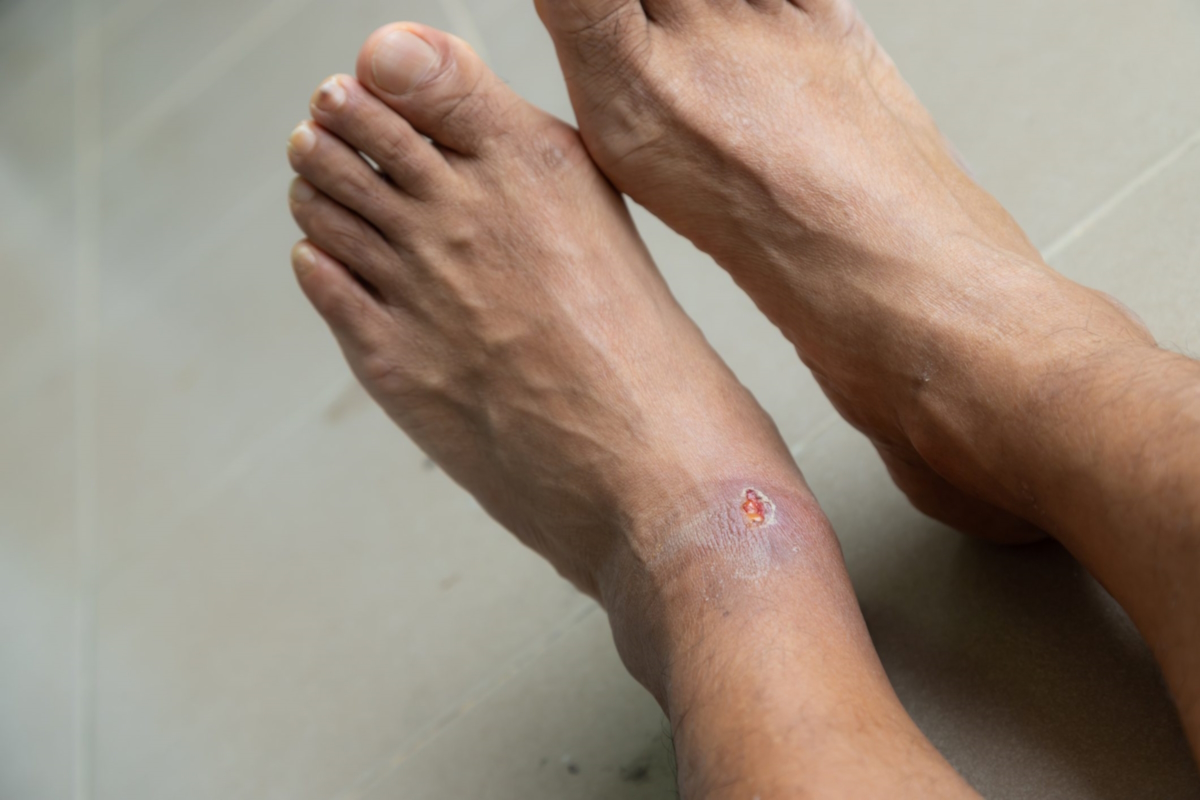
When you or a loved one are experiencing an open leg sore or wound, causing considerable pain and not healing as expected, it can quickly interrupt enjoying life fully. The good news is that a solution is possible, and help is close by. In such situations, achieving effective treatment for these open, swollen, red sores that leak fluid includes a vein and vascular specialist as part of your treatment team. This is because, what you are likely experiencing are venous leg ulcers—a telltale indication of underlying vein disease that must be treated before it worsens.
Our team of experts at StrideCare has long been a leader in multi-specialty care for treating lower-extremity vascular and podiatric conditions. That includes our ability to perform leading-edge procedures to treat artery and vein disease and symptoms that, while minor in their earliest stages, can lead to more severe issues such as venous leg ulcers. Our specialists can heal existing venous leg ulcers and prevent them from forming in the first place.
Do you have a leg wound that won’t heal? Request an appointment with a StrideCare vascular specialist today. Our collaborative approach ensures you receive the care you need.
How Do I Know If I Have Venous Leg Ulcers?
In general terms, venous leg ulcers are open wounds or a break in the skin that develops after a minor skin injury like a cut or scrape. The significant difference is that they worsen and expand instead of healing within a matter of days. These ulcers can be very painful and will ooze and bleed as tissue breaks down, leading to a noticeable open wound. They also present a heightened risk of infection as they continue to resist traditional treatments and generally don’t show improvement within a range of four weeks to three months.
Several types of ulcers can affect the legs and feet, depending on the cause (venous, arterial, pressure, and diabetic ulcers). Venous leg ulcers are the most common type of leg ulcer, affecting more than 200,000 people in the United States each year. They are typically found below the knees or on the inner side of the ankles.
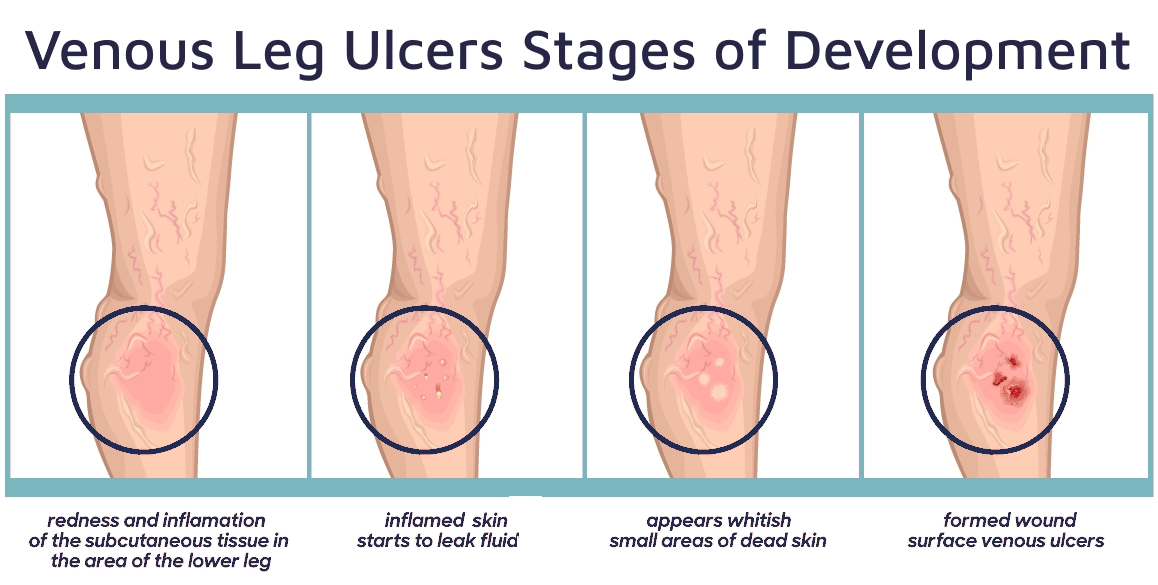
Common Venous Leg Ulcer Symptoms
- Leg pain that worsens as you stand
- Bloody or pus-filled drainage
- Scabbing, flaking, thickening, or itchy skin
- Hardened skin around the ulcer
- Skin discoloration
- Swelling in the affected leg
Many patients who experience venous leg ulcers ask if they are dangerous. And the quick answer is yes. When left untreated, venous leg ulcers are the perfect breeding ground for viral and bacterial infections that go beyond the traditional infection and could lead to cellulitis and gangrene. In extreme cases, these infections lead to necrosis (tissue death) and could result in leg amputation.
Conversely, effective medical treatment that focuses on the symptoms and the underlying condition can reduce your risk of complications and lead to a successful full recovery.
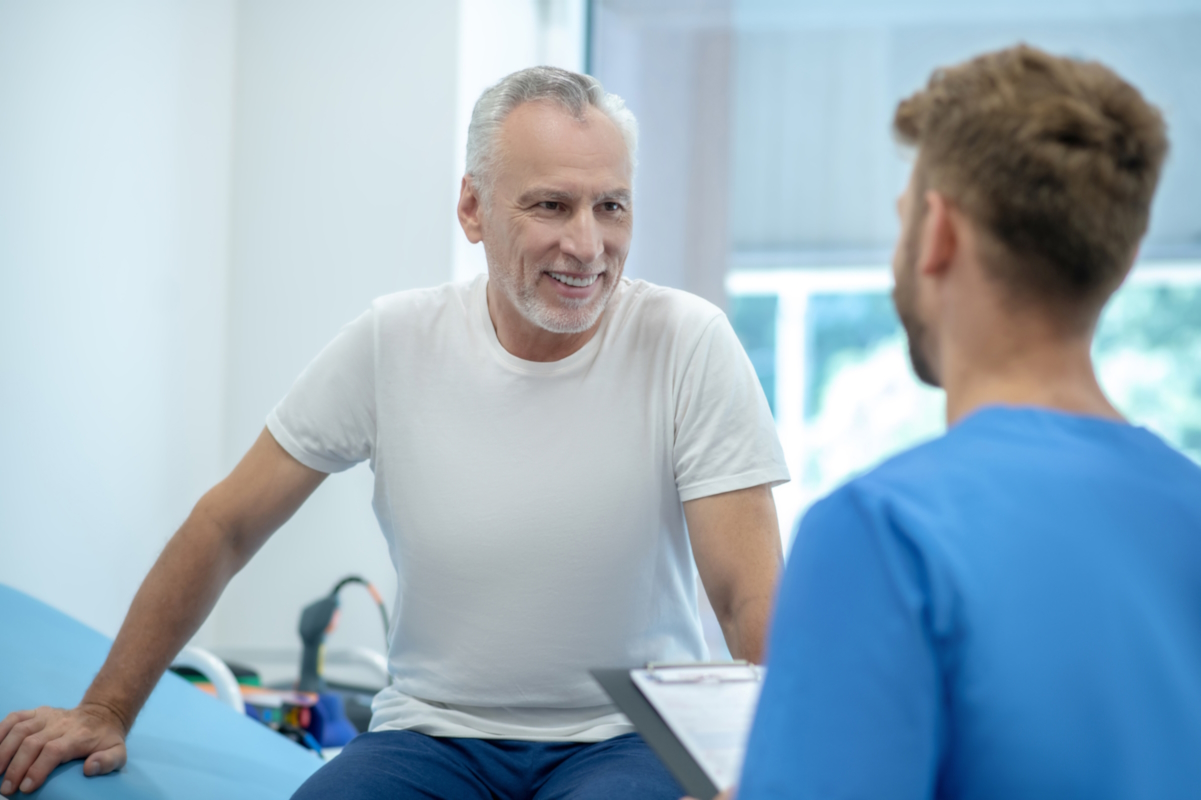
Vein Disease Is the Primary Cause of Venous Leg Ulcers
Individuals with venous leg ulcers typically have some degree of circulation problems in their veins. Think of your veins as a super network using a series of strong valves to carry deoxygenated blood back to the heart. This constant process works over and over again without you having to think about it and supports many systems critical to your cardiovascular health and other functions of blood.
The problem is that as we age, those same veins that were once healthy can become diseased with malfunctioning vein valves. As they weaken blood begins to slow to a crawl, and blood can begin flowing backward in the wrong direction. As a result, your veins start to bulge, stretch, and enlarge, and blood can pool in areas it should not.
An average of one in every three adults over 45 develops some form of vein disease. At first, you may only notice subtle changes to your skin, such as small and painless spider veins. Eventually, you notice large and bulging varicose veins that multiply as years pass. While an annoying cosmetic issue at first glance, these are the first signs that your vein health is in jeopardy.
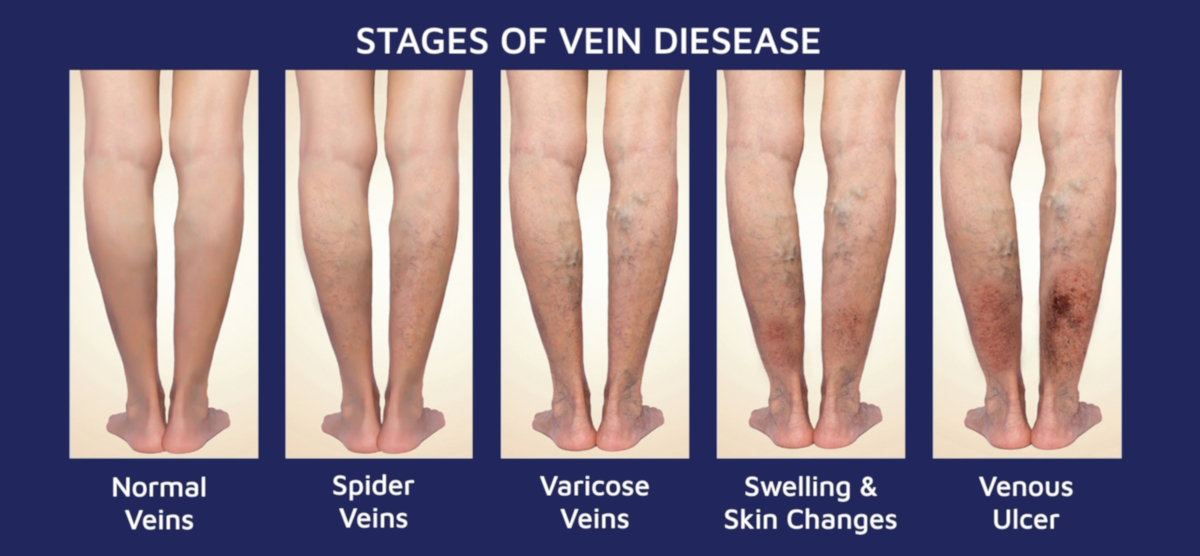
Not doing anything about it can lead to more complicated conditions such as deep vein thrombosis (DVT), restless leg syndrome, phlebitis, thrombophlebitis, and venous leg ulcers. Roughly 80% of all leg ulcers are caused by vein diseases. Your risk is compounded if your vascular health problems have caused neuropathy. Neuropathy reduces your skin’s sensitivity, increasing your risk of unnoticed injuries and infection.
Risk Factors for Venous Leg Ulcers
Many factors contribute to vein disease. These include:
- Genetics
- Age
- Gender
- Obesity
- Poor diet
- Excessive drinking and smoking
- Jobs that require a person to sit or stand for long periods
- Sedentary lifestyles
Are you experiencing leg ulcers interrupting your quality of life? Schedule a consultation with StrideCare’s expert physicians.
What Are Venous Leg Ulcer Treatment Options?
Our team at StrideCare has access to the most innovative treatment options to resolve your venous leg ulcers. This includes providing clean dressings and instructions for caring for your venous leg ulcers at home. Make sure to follow all instructions to reduce your risk of infection and promote healing. Ulcers can take a long time to heal, so don’t feel discouraged. Keeping your wounds clean and preventing infections is critical to your health. Large ulcers sometimes require surgery or skin grafts to close them.
With that said, venous leg ulcers will be easier to heal if we can also treat the root cause. Avoiding treating the root cause leaves you open to developing new wounds in the future. Our experts offer a variety of treatments to address vein disease, including but not limited to the following procedures:
1. Sclerotherapy
We inject a small amount of a specially formulated chemical solution full of sclerosing agents into the affected veins to reduce pain and discomfort caused by the enlargement or swelling of the veins. This solution irritates the vein walls and causes the vein to collapse and disappear.
2. Microfoam Ablation
A special microfoam is injected into your affected veins to relieve symptoms without heat or tumescent. The foam fills the desired section of the vein, and the diseased vein collapses. Blood flow then shifts to healthier veins nearby.
3. Radiofrequency Ablation (RFA)
A catheter is inserted into the diseased vein through a small puncture. The catheter is guided up into the great saphenous vein in the thigh or the small saphenous vein in the calf. The radiofrequency energy is delivered to the inside of the vein, cutting off blood flow and relieving symptoms.
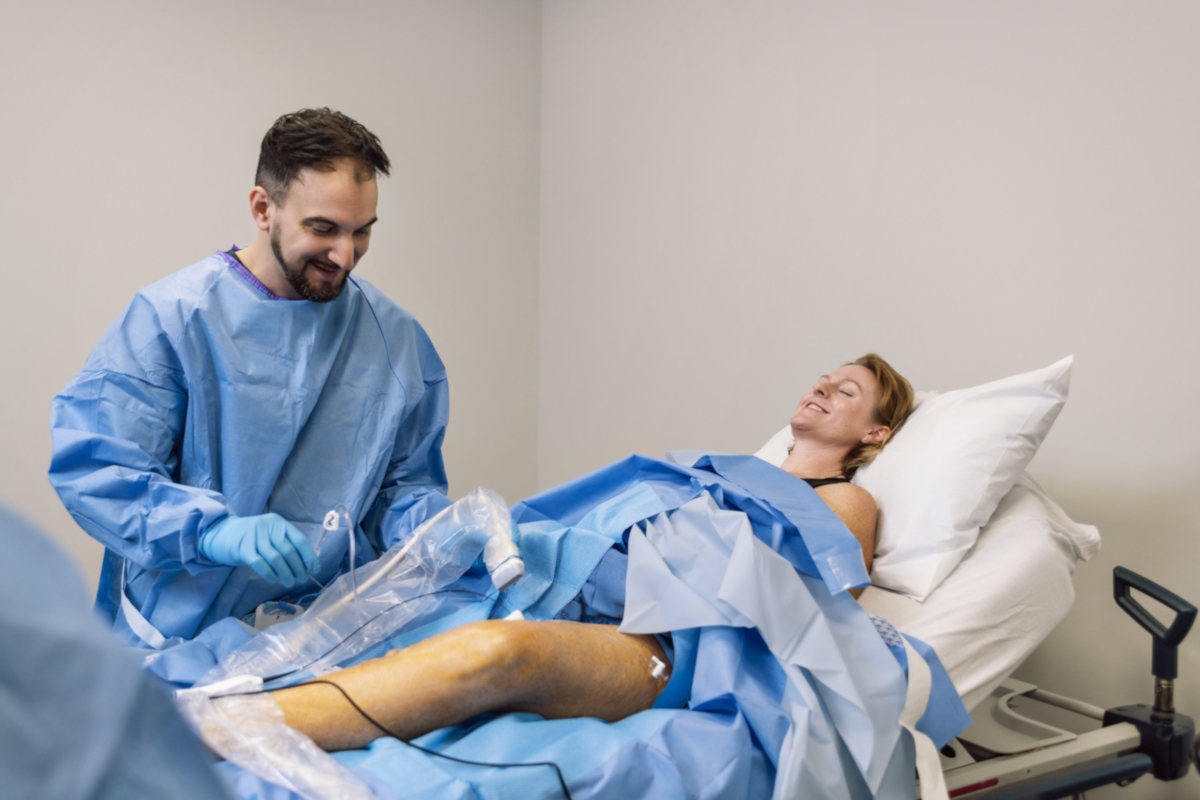
The good news is that your venous leg wound can be treated with an accurate diagnosis and a multidisciplinary approach with wound care doctors and other specialists.
Trust StrideCare for Venous Leg Ulcers and Vein Disease Needs
A consultation with your vein doctor can determine the type, severity, and location of your particular vein problem. We use the latest ultrasound equipment to determine the cause of your venous leg ulcer. This allows us to get an inside look at the performance of your vascular system, and we pay close attention to every detail. A venogram can uncover additional findings if a diagnostic venous ultrasound doesn’t provide a clear enough picture.
The key is not to delay seeking help—especially if you have venous leg ulcers. Our expert doctors and caring staff utilize the latest technologies and minimally invasive procedures to help our patients reclaim their lives.
StrideCare has long been a leader in multi-specialty care for treating lower-extremity vascular and podiatric conditions. That includes our ability to perform leading-edge procedures to treat artery and vein disease and symptoms that, while minor in their earliest stages, can eventually lead to more serious and life interrupting issues. The experts at StrideCare will recommend an individualized plan to help you get the best results.
Please contact us at 866-552-4866 or complete the appointment form to schedule a consultation. We are here to help, all while providing compassionate patient care.
Prior to starting any new treatment or questions regarding a medical condition, always seek the advice of your doctor or other qualified health provider. This information is not a substitute for professional medical advice.
StrideCare serves North Texas and South Texas communities, including Houston, Sugar Land, Katy, Webster, Clear Lake, The Woodlands, Lake Jackson, San Antonio, Stone Oak, Austin, Round Rock, Bastrop, Brushy Creek, Cedar Park, Converse, Georgetown, Hutto, Kyle, Leander, Marble Falls, New Braunfels, Pasadena, Pearland, Pflugerville, San Marcos, Schertz, Bay City, Universal City, Spring, Kingwood, Stafford, Conroe, Texas City, Cypress, League City, Bellaire, Dallas, Mesquite, Addison, Arlington, Plano, McKinney, Craig Ranch, Prosper, Flower Mound, Euless, Southlake, South Dallas, Sherman, Irving, Garland, Carrollton, Rowlett, Coppell, Forney, Rockwall, and more.
*Patient stories are true. Names and/or photos may be changed to protect patient confidentiality.


